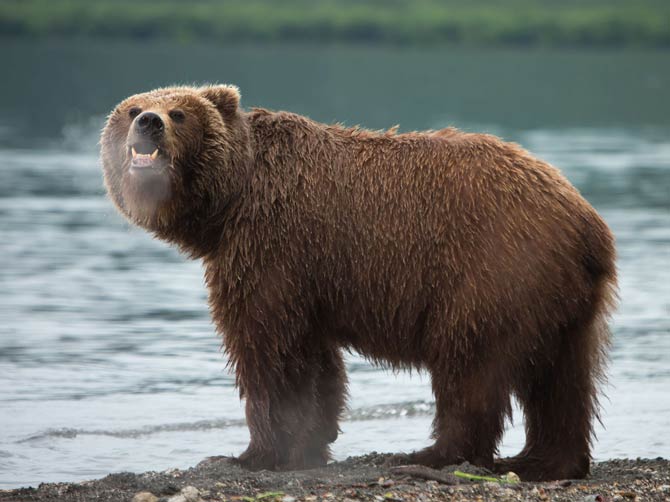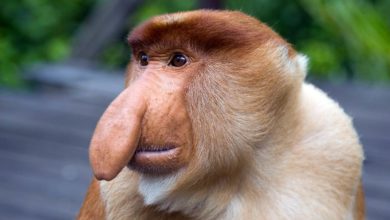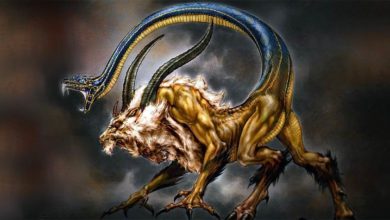Kamchatka brown bear (Ursus arctos beringianus)
The Kamchatka brown bear, also known as the Far Eastern brown bear, is a subspecies of brown bear that is native to the Kamchatka Peninsula in far eastern Russia. It is one of the largest subspecies of brown bear, with males weighing up to 680 kilograms (1,500 pounds) and females weighing up to 400 kg (900 pounds).
Kamchatka brown bears are omnivorous, feeding on a variety of plants, berries, nuts, and insects as well as fish and small mammals. They are known to feed on salmon and other fish during the summer months, and they will also scavenge for food, including the remains of marine mammals and other animals.
Kamchatka brown bears are typically found in dense forests and along rivers and streams. They have a strong affinity for water and are often seen near rivers and streams, where they feed on fish. They are generally solitary animals and are not known to form large social groups like some other bear species.
Kamchatka brown bears are endangered due to habitat loss and poaching. Efforts are being made to protect and preserve their natural habitat, and the hunting of Kamchatka brown bears is strictly regulated in Russia.
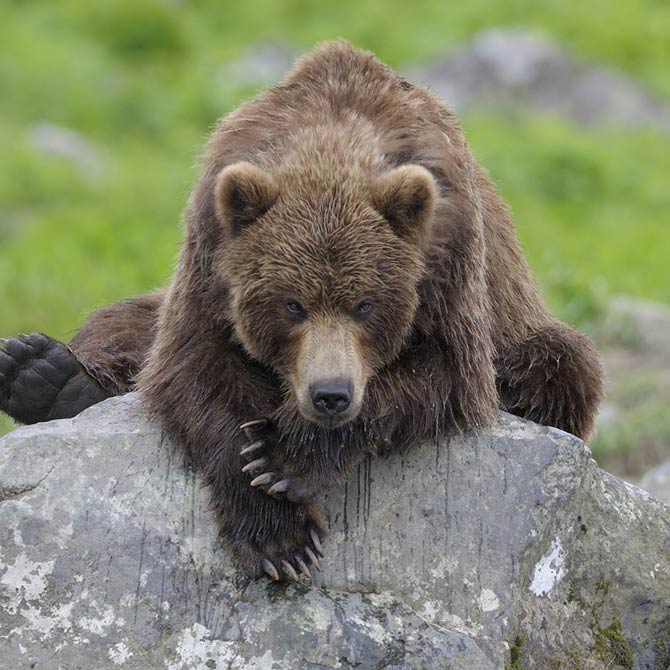
Taxonomy
Brown bears, including the Kamchatka brown bear, belong to the family Ursidae, which includes all species of bear. Within the family Ursidae, the brown bear belongs to the genus Ursus, which includes all species of bear except for the polar bear (Ursus maritimus).
Taxonomy is the scientific study of the classification and naming of organisms. In taxonomy, organisms are classified based on their characteristics and relationships to other organisms, and are given scientific names according to a standardized system known as binomial nomenclature. The Kamchatka brown bear is classified as follows:
- Kingdom: Animalia (animals)
- Phylum: Chordata (animals with a backbone)
- Class: Mammalia (mammals)
- Order: Carnivora (carnivorous mammals)
- Family: Ursidae (bears)
- Genus: Ursus (brown bears)
- Species: Ursus arctos (brown bear)
- Subspecies: Ursus arctos beringianus (Kamchatka brown bear)
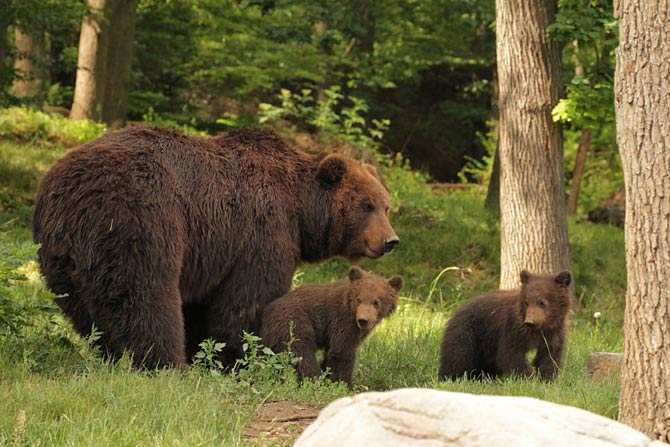
Description / characteristics
The Kamchatka brown bear is a large subspecies of brown bear that is native to the Kamchatka Peninsula in far eastern Russia. It is one of the largest subspecies of brown bear, with males weighing up to 1,500 pounds and females weighing up to 900 pounds.
Kamchatka brown bears have a thick, shaggy coat that is typically a dark brown color, although some individuals may have a lighter or reddish-brown coat. Their head is large and rounded, with small, rounded ears and a long, narrow snout. They have long, sharp claws that are used for digging and climbing, as well as for capturing and killing prey.
Kamchatka brown bears are omnivorous, feeding on a variety of plants, berries, nuts, and insects as well as fish and small mammals. They are known to feed on salmon and other fish during the summer months, and they will also scavenge for food, including the remains of marine mammals and other animals.
Kamchatka brown bears are typically found in dense forests and along rivers and streams. They have a strong affinity for water and are often seen near rivers and streams, where they feed on fish. They are generally solitary animals and are not known to form large social groups like some other bear species.
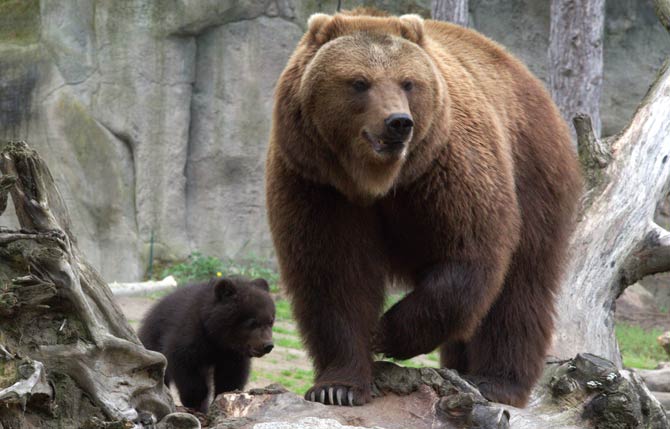
Size
The size of an individual Kamchatka brown bear can vary significantly based on a number of factors, including its age, sex, and diet.
Males of this subspecies can reach a length of up to 2.5 meters (8 feet 2 inches) and a shoulder height of up to 1.4 meters (4 feet 7 inches). They can weigh up to 680 kilograms (1,500 pounds).
Females are generally smaller, reaching a length of up to 2 meters (6 feet 7 inches) and a shoulder height of up to 1.2 meters (3 feet 11 inches). They can weigh up to 400 kilograms (880 pounds).
It is important to note that these are approximate sizes and that individual bears may be larger or smaller. It is also worth noting that these measurements are for the Kamchatka brown bear subspecies specifically and that brown bears from other regions can vary in size.
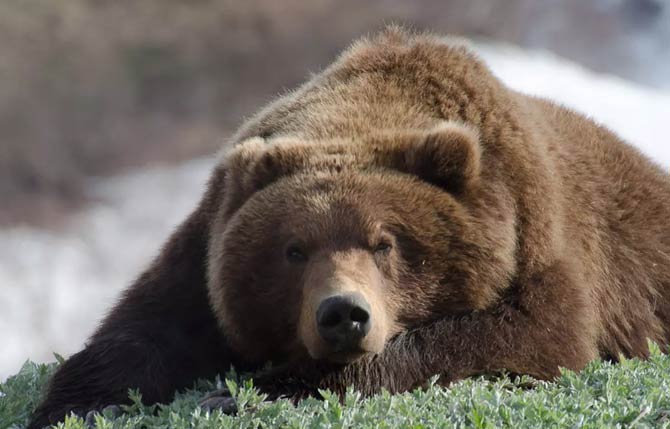
Food
As omnivorous mammals, Kamchatka brown bears feed on a wide variety of plant and animal matter. The bears are opportunistic feeders and will eat whatever food is available, depending on the season and their location.
In the spring and summer months, Kamchatka brown bears feed on a variety of plant materials, including berries, nuts, roots, and shoots. They also feed on insects, small mammals, and birds, and may fish for salmon in streams and rivers.
In the fall, the bears enter a period of hyperphagia, during which they consume large amounts of food in preparation for winter hibernation. During this time, the bears may feed on a variety of plant and animal matter, including berries, nuts, roots, insects, small mammals, and fish.
During the winter months, the bears den up in a sheltered location and sleep through the cold weather, surviving on their stored fat reserves.

Distribution
The Kamchatka brown bear is native to the Kamchatka Peninsula in eastern Russia, which is located in the far northwest of the Pacific Rim. The Kamchatka Peninsula is a large, sparsely populated region that is home to a number of unique and endangered species, including the Kamchatka brown bear.
The Kamchatka brown bear is found throughout the Kamchatka Peninsula, with the highest densities occurring in the central and southern parts of the peninsula. The bears are also found on the nearby Kuril Islands and on the Russian mainland, as far east as the Koryak Plateau.
The Kamchatka brown bear is adapted to a wide range of habitats, including tundra, taiga (boreal forest), and alpine meadows. The bears are highly dependent on salmon as a food source, and are often found near rivers and streams where salmon spawn.

Behavior and ecology
The Kamchatka brown bear is a large, omnivorous mammal that plays a crucial role in the ecosystem of the Kamchatka Peninsula. As a top predator, the bear helps to regulate the populations of other species and plays a key role in the cycling of nutrients through the ecosystem.
Brown bears, including the Kamchatka brown bear, are generally solitary animals, although they may come into contact with each other when food sources are scarce or when females are in estrus. Males are larger than females and have a home range that is typically three to five times larger than that of females.
Kamchatka brown bears are most active during the spring and summer months, when they feed on a wide variety of plant and animal matter. The bears are opportunistic feeders and will eat whatever food is available, including berries, nuts, roots, insects, small mammals, and fish. Salmon is a particularly important food source for Kamchatka brown bears, and the bears will often fish for salmon in streams and rivers during the summer months.
In the fall, Kamchatka brown bears enter a period of hyperphagia, during which they consume large amounts of food in preparation for winter hibernation. During the winter months, the bears den up in a sheltered location and sleep through the cold weather, surviving on their stored fat reserves.
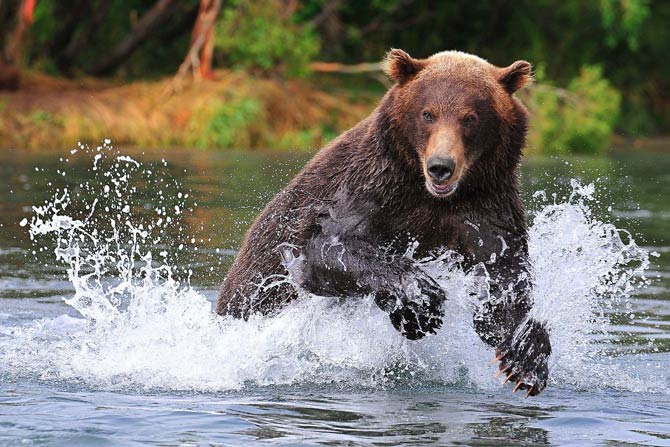
Reproduction and parenting
Kamchatka brown bears are generally solitary animals, although they may come into contact with each other when food sources are scarce or when females are in estrus.
Female Kamchatka brown bears reach sexual maturity at around the age of 5-6 years, and males at around the age of 6-7 years. Mating typically occurs in late spring or early summer, and females give birth to their cubs in the winter, while they are denning up for hibernation.
Females typically give birth to one to three cubs, which are born blind, deaf, and helpless. The cubs weigh only about 500 grams (1 pound) at birth, but grow rapidly and are weaned at around the age of six months.
Female Kamchatka brown bears are known for their strong maternal bond with their cubs, and will fiercely defend their cubs against any perceived threats. The cubs remain with their mother for the first two to three years of their life, during which time they learn important survival skills such as how to find food and avoid danger.
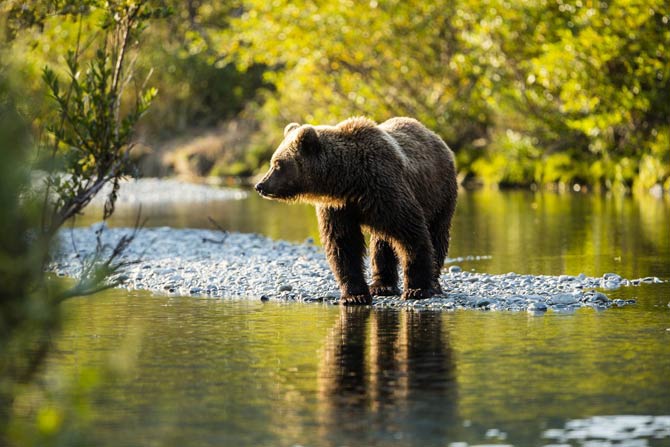
Relationship with humans
The Kamchatka brown bear is an important cultural and ecological symbol in eastern Russia, and has a long history of interaction with humans. In the past, bears were hunted for their meat, fur, and other products, and were also feared as a potential threat to humans.
Today, the Kamchatka brown bear is protected by Russian law, and hunting is strictly regulated. Despite this, the bears do sometimes come into conflict with humans, particularly when they are attracted to human settlements or agricultural areas in search of food. In these cases, conservation and wildlife management agencies may take steps to minimize the risk of conflict, such as relocating the bears or using non-lethal methods to deter them.
In some parts of the Kamchatka Peninsula, the bears are also used in ecotourism, and tourists can observe the bears in their natural habitat from a safe distance. This type of tourism can provide economic benefits to local communities and help to raise awareness about the importance of bear conservation.
It is important for people to be aware of the potential risks of encountering bears in the wild and to take appropriate precautions to avoid conflict. This may include carrying bear spray or making noise to alert the bears to your presence.
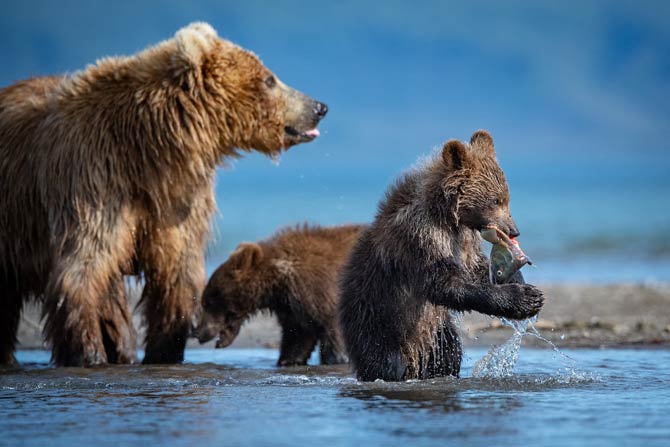
Trophy hunting
Trophy hunting is a controversial practice in which hunters pay to hunt and kill wild animals, often for the purpose of displaying the animal’s head, antlers, or other body parts as a trophy. Trophy hunting has been linked to the decline of some species, and has been criticized by conservationists and animal welfare advocates as unethical and unsustainable.
In Russia, the hunting of Kamchatka brown bears is strictly regulated by the government. Hunting is only allowed in certain areas and seasons, and hunters are required to obtain a hunting license and follow specific rules and regulations. Trophy hunting of Kamchatka brown bears is allowed in some parts of the Kamchatka Peninsula, but is subject to strict quotas and other regulations.
The hunting of Kamchatka brown bears is a controversial issue, with some people arguing that it is an important economic activity for local communities and helps to fund conservation efforts, while others argue that it is unethical and harmful to the bears and the ecosystem.
It is important for any hunting activity to be carefully regulated and monitored to ensure that it is sustainable and does not pose a threat to the long-term survival of the species being hunted.

Conservation
The Kamchatka brown bear is a protected species in Russia, and various conservation efforts are in place to help ensure the long-term survival of the species.
The main threat to Kamchatka brown bears is habitat loss and degradation, which can be caused by a variety of factors, including logging, mining, and other forms of development. To help protect the bears’ habitat, conservation organizations and government agencies are working to establish protected areas and implement land use policies that prioritize the conservation of natural habitats.
Other conservation efforts for Kamchatka brown bears include research and monitoring programs, which help to improve our understanding of the bears’ biology, behavior, and ecology. This information is used to inform conservation and management decisions and to develop effective strategies for protecting the bears.
In addition to these efforts, there are also educational programs and outreach initiatives aimed at raising awareness about the importance of bear conservation and promoting coexistence between bears and humans.
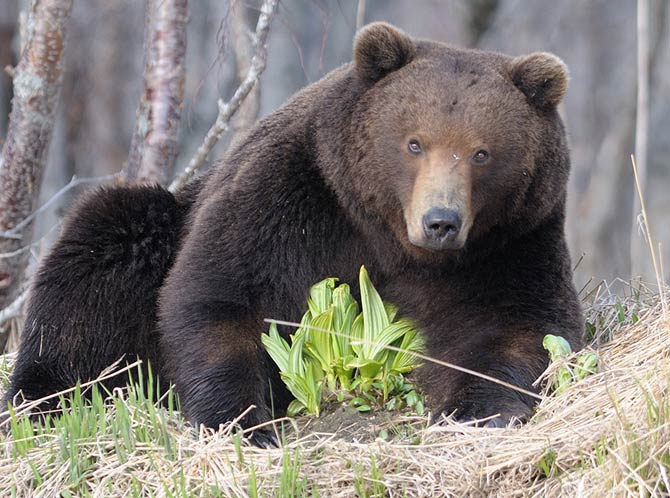
In captivity
Kamchatka brown bears are not commonly kept in captivity, as they are large, powerful animals that are adapted to living in the wild. In Russia, the hunting and possession of Kamchatka brown bears is strictly regulated, and it is illegal to keep the bears as pets or in private collections.
However, some Kamchatka brown bears may be kept in zoos or wildlife sanctuaries for conservation or educational purposes. In these settings, the bears are typically provided with enclosures that mimic their natural habitat and are designed to meet their physical, social, and behavioral needs.
It is important to remember that while zoos and wildlife sanctuaries can provide a valuable opportunity for people to learn about and appreciate wildlife, they can also present challenges for the animals that are kept there. For this reason, it is important for facilities that keep bears in captivity to adhere to high standards of care and to prioritize the well-being of the animals.
Detailed data and dimensions (size)
Kamchatka brown bear (Ursus arctos beringianus)
- Body length:
- Males: 2.5 meters (8 feet 2 inches)
- Males standing on hind legs: 3 m (9.8 ft) tall
- Females: 2 meters (6 feet 7 inches)
- Height:
- Males: 1.4 meters (4 feet 7 inches)
- Females: 1.2 meters (3 feet 11 inches)
- Weight:
- Males: at least 650 kg (1,430 lb)
- Females: up to 400 kilograms (880 pounds)
- Lifespan: up to approx. 25 years in the wild, over 30 years in captivity
Interesting facts about Kamchatka brown bears
- Kamchatka brown bears are one of the largest subspecies of brown bear.
- Kamchatka brown bears are native to the Kamchatka Peninsula in eastern Russia, which is located in the far northwest of the Pacific Rim.
- Kamchatka brown bears are omnivorous and will eat a wide variety of plant and animal matter, including berries, nuts, roots, insects, small mammals, and fish. Salmon is a particularly important food source for bears.
- Kamchatka brown bears enter a period of hyperphagia in the fall, during which they consume large amounts of food in preparation for winter hibernation. During the winter months, the bears den up in a sheltered location and sleep through the cold weather, surviving on their stored fat reserves.
- Female Kamchatka brown bears give birth to one to three cubs in the winter, while they are denning up for hibernation. The cubs remain with their mother for the first two to three years of their life, during which time they learn important survival skills.
- Kamchatka brown bears are protected by Russian law, and hunting is strictly regulated. However, the bears do sometimes come into conflict with humans, particularly when they are attracted to human settlements or agricultural areas in search of food.
- Kamchatka brown bears are an important cultural and ecological symbol in eastern Russia, and are the focus of various conservation efforts, including research and monitoring programs, habitat protection, and educational initiatives.
